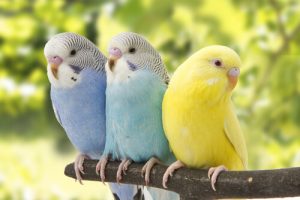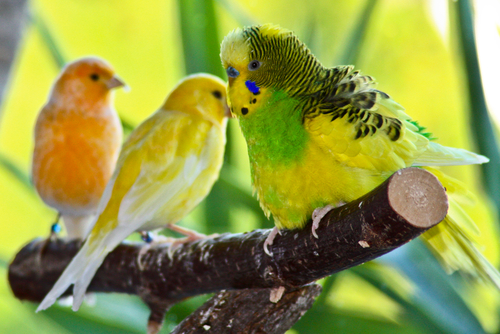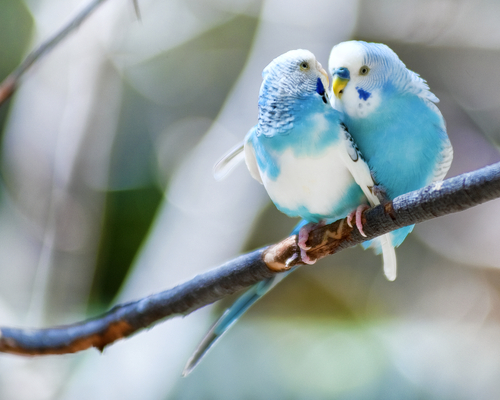Bird Care 101: How to Take Care of Parakeets


Written and verified by the lawyer Francisco María García
Parakeets are the third most popular pet after dogs and cats. They are not expensive, but it is important to give them the attention they need to make them feel at ease. In this article, we’ll tell you how to care for a parakeet. What kind of cage, environment and food are the most suitable?
The parakeet is a bird with an average life span of 11 years. It makes an ideal pet because it integrates into family life when given the chance. You can even teach it to say certain words.
In Australia, where parakeets comes from, they live in flocks. That is why they should usually live with companions, preferably of their own species.
Keys to caring for your parakeet
-
Choosing a cage
It is an animal that needs space and flies mainly horizontally. Therefore, the ideal size of the cage should not be less than 70 cm in length with a width of about 40 cm. This makes it easier to move around and play, which they enjoy.

-
The inside of the cage
A food dish, water bottle, and a cuttlefish bone for the bird to sharpen its beak and nails on– those are the basic elements of parakeet care. Always prioritize their safety and comfort.
It is advisable to use feeders with an open upper mouth and plastic containers that make cleaning easier.
In addition, it is good to incorporate cross bars so that they can perch and exercise their legs. Natural materials like wood are the best choice.
Toys of varying sizes and colors, as well as bathtubs, can stimulate your pet. They love to cool off, and it’s a way for them to maintain their hygiene themselves. It is important to keep in mind that you must change the water daily.
-
An ideal place
An important point to consider for parakeet care is deciding where to put the cage.
It is recommended to look for places where they will get enough light, but will not be exposed to direct sunlight. Avoid spaces where there are sudden changes in temperatures, or air currents. For example, do not place the cages in kitchens, or next to open doors or windows.
It is also advisable to not constantly change the cage’s location.
-
Higiene
You must clean the cage every day. Remove the bottom, containing the leftover food and debris. Once a week, wash it with water or mild soap. Be sure to use non-toxic products.
You must change the wooden sticks every so often, and insure the cleanliness of the food and drink containers.
-
Food
A parakeet’s diet must be varied. A mixture of seeds, fruits and vegetables is ideal. Parakeets love fresh, washed and dried lettuce. They also eat fruit, like apples.

-
Create the best environment
Once the place has been decided and you’ve confirmed that it is comfortable, prepare the bird’s environment for resting. Cover the cage with a cloth, leaving a hole for oxygen.
It is also necessary to achieve, little by little, interaction with the bird. Keep in mind that it is beneficial to let him out on occasion, provided you do it in a closed room. As long as you use proper safety measures and keep in mind that the room could get dirty, there’s no problem.
-
Care for his health
As with every pet, you need to take care of your bird’s health. To do this, it is important to be attentive to possible changes in his behavior or size.
-
Reproduction
It is advisable that the parakeet coexist with others of its kind. Two males, or a male and a female can be joined in the same cage. Avoid the coexistence of two females.
Finally, it is advisable not to cut the wings or the claws if it is not done by a professional.
Parakeets are the third most popular pet after dogs and cats. They are not expensive, but it is important to give them the attention they need to make them feel at ease. In this article, we’ll tell you how to care for a parakeet. What kind of cage, environment and food are the most suitable?
The parakeet is a bird with an average life span of 11 years. It makes an ideal pet because it integrates into family life when given the chance. You can even teach it to say certain words.
In Australia, where parakeets comes from, they live in flocks. That is why they should usually live with companions, preferably of their own species.
Keys to caring for your parakeet
-
Choosing a cage
It is an animal that needs space and flies mainly horizontally. Therefore, the ideal size of the cage should not be less than 70 cm in length with a width of about 40 cm. This makes it easier to move around and play, which they enjoy.

-
The inside of the cage
A food dish, water bottle, and a cuttlefish bone for the bird to sharpen its beak and nails on– those are the basic elements of parakeet care. Always prioritize their safety and comfort.
It is advisable to use feeders with an open upper mouth and plastic containers that make cleaning easier.
In addition, it is good to incorporate cross bars so that they can perch and exercise their legs. Natural materials like wood are the best choice.
Toys of varying sizes and colors, as well as bathtubs, can stimulate your pet. They love to cool off, and it’s a way for them to maintain their hygiene themselves. It is important to keep in mind that you must change the water daily.
-
An ideal place
An important point to consider for parakeet care is deciding where to put the cage.
It is recommended to look for places where they will get enough light, but will not be exposed to direct sunlight. Avoid spaces where there are sudden changes in temperatures, or air currents. For example, do not place the cages in kitchens, or next to open doors or windows.
It is also advisable to not constantly change the cage’s location.
-
Higiene
You must clean the cage every day. Remove the bottom, containing the leftover food and debris. Once a week, wash it with water or mild soap. Be sure to use non-toxic products.
You must change the wooden sticks every so often, and insure the cleanliness of the food and drink containers.
-
Food
A parakeet’s diet must be varied. A mixture of seeds, fruits and vegetables is ideal. Parakeets love fresh, washed and dried lettuce. They also eat fruit, like apples.

-
Create the best environment
Once the place has been decided and you’ve confirmed that it is comfortable, prepare the bird’s environment for resting. Cover the cage with a cloth, leaving a hole for oxygen.
It is also necessary to achieve, little by little, interaction with the bird. Keep in mind that it is beneficial to let him out on occasion, provided you do it in a closed room. As long as you use proper safety measures and keep in mind that the room could get dirty, there’s no problem.
-
Care for his health
As with every pet, you need to take care of your bird’s health. To do this, it is important to be attentive to possible changes in his behavior or size.
-
Reproduction
It is advisable that the parakeet coexist with others of its kind. Two males, or a male and a female can be joined in the same cage. Avoid the coexistence of two females.
Finally, it is advisable not to cut the wings or the claws if it is not done by a professional.
This text is provided for informational purposes only and does not replace consultation with a professional. If in doubt, consult your specialist.








